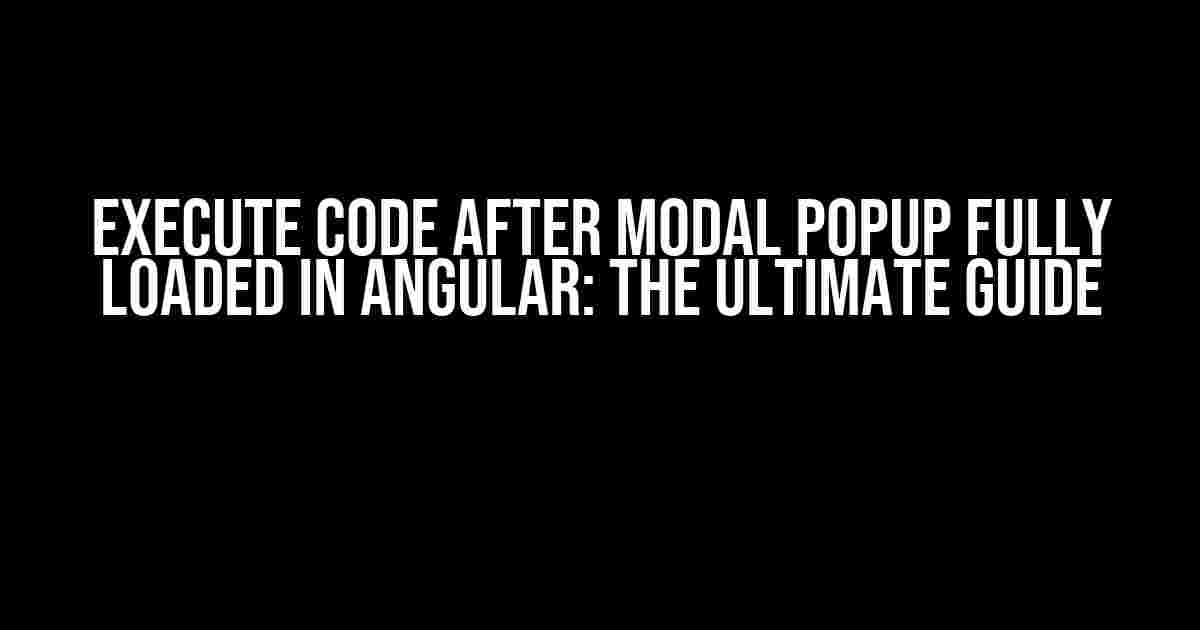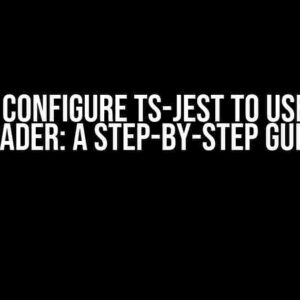Are you tired of struggling to execute code after a modal popup has fully loaded in your Angular application? Well, worry no more! In this comprehensive guide, we’ll take you through the step-by-step process of achieving this feat with ease. By the end of this article, you’ll be a master of modal popup manipulation in Angular.
What’s the Problem, Anyway?
In Angular, when a modal popup is triggered, it takes some time to fully load and render its content. During this time, if you try to execute some code, it might not work as expected or produce errors. This is because the modal popup is still in the process of loading, and your code is trying to interact with an incomplete or non-existent component.
Symptoms of the Problem
- Code execution fails or produces errors
- Modal popup content is not fully loaded before code execution
- Inconsistent behavior or unexpected results
Solution 1: Using the afterOpen() Method
The first solution is to use the built-in `afterOpen()` method provided by the Angular Material library. This method is triggered after the modal popup has fully opened and the content has been loaded.
import { Component, ViewContainerRef } from '@angular/core';
import { MatDialog } from '@angular/material/dialog';
@Component({
selector: 'app-modal-popup',
template: `
<button mat-button (click)="openDialog()">Open Dialog</button>
<mat-dialog-content>
<h1>Modal Popup Content</h1>
</mat-dialog-content>
`
})
export class ModalPopupComponent {
constructor(public dialog: MatDialog, public viewContainerRef: ViewContainerRef) {}
openDialog() {
const dialogRef = this.dialog.open(DialogContentComponent, {
width: '500px',
data: {}
});
dialogRef.afterOpen().subscribe(() => {
// Execute code after modal popup has fully loaded
console.log('Modal popup has fully loaded!');
});
}
}
@Component({
selector: 'app-dialog-content',
template: `
<p>This is the dialog content</p>
`
})
export class DialogContentComponent {}
How it Works
The `afterOpen()` method returns an observable that emits a value when the modal popup has fully opened and the content has been loaded. By subscribing to this observable, you can execute code after the modal popup has fully loaded.
Solution 2: Using a Promise
The second solution is to use a promise to wait for the modal popup to fully load before executing code. This approach is useful when you need more control over the loading process.
import { Component, ViewContainerRef } from '@angular/core';
import { MatDialog } from '@angular/material/dialog';
@Component({
selector: 'app-modal-popup',
template: `
<button mat-button (click)="openDialog()">Open Dialog</button>
<mat-dialog-content>
<h1>Modal Popup Content</h1>
</mat-dialog-content>
`
})
export class ModalPopupComponent {
constructor(public dialog: MatDialog, public viewContainerRef: ViewContainerRef) {}
openDialog() {
const dialogRef = this.dialog.open(DialogContentComponent, {
width: '500px',
data: {}
});
dialogRef.componentInstance.loadingPromise = new Promise(resolve => {
setTimeout(() => {
resolve();
}, 1000); // Wait for 1 second
});
dialogRef.componentInstance.loadingPromise.then(() => {
// Execute code after modal popup has fully loaded
console.log('Modal popup has fully loaded!');
});
}
}
@Component({
selector: 'app-dialog-content',
template: `
<p>This is the dialog content</p>
`
})
export class DialogContentComponent {
loadingPromise: Promise;
}
How it Works
In this solution, we create a promise in the `openDialog()` method and set it to the `componentInstance` property of the `dialogRef`. We then use `setTimeout()` to wait for a certain amount of time (in this case, 1 second) before resolving the promise. Once the promise is resolved, we can execute code after the modal popup has fully loaded.
Solution 3: Using a Callback Function
The third solution is to use a callback function to execute code after the modal popup has fully loaded. This approach is useful when you need to pass data from the modal popup to the parent component.
import { Component, ViewContainerRef } from '@angular/core';
import { MatDialog } from '@angular/material/dialog';
@Component({
selector: 'app-modal-popup',
template: `
<button mat-button (click)="openDialog()">Open Dialog</button>
<mat-dialog-content>
<h1>Modal Popup Content</h1>
</mat-dialog-content>
`
})
export class ModalPopupComponent {
constructor(public dialog: MatDialog, public viewContainerRef: ViewContainerRef) {}
openDialog() {
const dialogRef = this.dialog.open(DialogContentComponent, {
width: '500px',
data: {}
});
dialogRef.componentInstance.onLoad = () => {
// Execute code after modal popup has fully loaded
console.log('Modal popup has fully loaded!');
};
}
}
@Component({
selector: 'app-dialog-content',
template: `
<p>This is the dialog content</p>
`
})
export class DialogContentComponent {
onLoad: () => void;
ngAfterViewInit() {
this.onLoad();
}
}
How it Works
In this solution, we define a callback function `onLoad` in the `DialogContentComponent` and pass it to the `onLoad` property of the `componentInstance`. In the `ngAfterViewInit()` lifecycle hook, we call the `onLoad` function, which executes the code after the modal popup has fully loaded.
Conclusion
In this article, we’ve covered three solutions to execute code after a modal popup has fully loaded in Angular. Each solution has its own strengths and weaknesses, and you can choose the one that best fits your use case. By following these solutions, you’ll be able to overcome the challenges of modal popup manipulation in Angular and create a seamless user experience.
Best Practices
- Use the `afterOpen()` method for simple use cases
- Use a promise or callback function for more complex scenarios
- Avoid using timeouts or other hacks to wait for the modal popup to load
- Test your implementation thoroughly to ensure it works as expected
| Solution | Description | Advantages | Disadvantages |
|---|---|---|---|
| Using afterOpen() | Uses the built-in afterOpen() method | Easy to implement, simple to use | Limited control over the loading process |
| Using a Promise | Uses a promise to wait for the modal popup to load | More control over the loading process, flexible | Requires more boilerplate code |
| Using a Callback Function | Uses a callback function to execute code after the modal popup has loaded | Passes data from the modal popup to the parent component, flexible | Requires more boilerplate code, can be complex |
By following the best practices and considering the advantages and disadvantages of each solution, you’ll be able to choose the right approach for your Angular application. Happy coding!
Here is the FAQ section about “Execute code after modal popup fully loaded in angular” in a creative voice and tone:
Frequently Asked Question
Got stuck with modals? Don’t worry, we’ve got you covered! Below are some frequently asked questions about executing code after a modal popup is fully loaded in Angular.
How do I know when a modal is fully loaded in Angular?
You can use the `opened` event of the modal component to execute code when the modal is fully loaded. This event is emitted when the modal is fully opened and the animation is complete. You can also use a timeout or a promise to wait for the modal to finish loading before executing your code.
Can I use the `afterOpen` callback function to execute code after a modal is fully loaded?
Yes, you can! The `afterOpen` callback function is a built-in feature in many modal libraries, including ng-bootstrap. This function is called after the modal is fully loaded and is a great way to execute code once the modal is ready.
What if I’m using a custom modal component and don’t have access to the `opened` event or `afterOpen` callback?
Don’t worry! You can still use a timeout or a promise to wait for the modal to finish loading before executing your code. Alternatively, you can create a custom event or callback function in your modal component to notify the parent component when the modal is fully loaded.
How do I execute code after a modal is fully loaded and all animations are complete?
You can use the `animationEnd` event of the modal component to execute code after all animations are complete. This event is emitted when all animations are finished, ensuring that your code is executed only after the modal is fully loaded and all animations are complete.
Are there any performance considerations when executing code after a modal is fully loaded?
Yes, there are! When executing code after a modal is fully loaded, be mindful of performance considerations. Avoid executing heavy code or making unnecessary HTTP requests that can slow down your application. Instead, focus on executing lightweight code that enhances the user experience without compromising performance.


